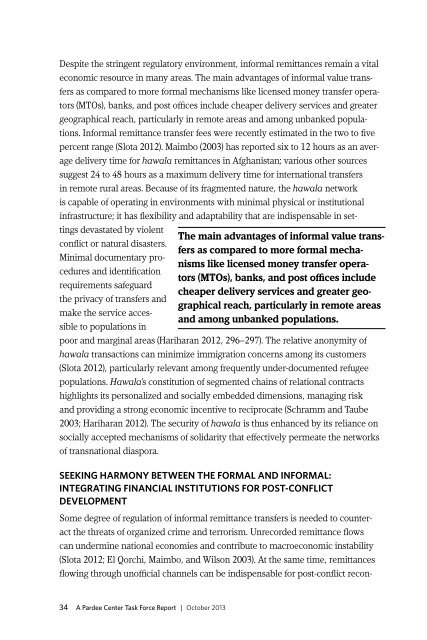Pardee-CFLP-Remittances-TF-Report
Pardee-CFLP-Remittances-TF-Report
Pardee-CFLP-Remittances-TF-Report
Create successful ePaper yourself
Turn your PDF publications into a flip-book with our unique Google optimized e-Paper software.
Despite the stringent regulatory environment, informal remittances remain a vitaleconomic resource in many areas. The main advantages of informal value transfersas compared to more formal mechanisms like licensed money transfer operators(MTOs), banks, and post offices include cheaper delivery services and greatergeographical reach, particularly in remote areas and among unbanked populations.Informal remittance transfer fees were recently estimated in the two to fivepercent range (Slota 2012). Maimbo (2003) has reported six to 12 hours as an averagedelivery time for hawala remittances in Afghanistan; various other sourcessuggest 24 to 48 hours as a maximum delivery time for international transfersin remote rural areas. Because of its fragmented nature, the hawala networkis capable of operating in environments with minimal physical or institutionalinfrastructure; it has flexibility and adaptability that are indispensable in settingsdevastated by violentconflict or natural disasters.Minimal documentary proceduresand identificationrequirements safeguardthe privacy of transfers andmake the service accessibleto populations inThe main advantages of informal value transfersas compared to more formal mechanismslike licensed money transfer operators(MTOs), banks, and post offices includecheaper delivery services and greater geographicalreach, particularly in remote areasand among unbanked populations.poor and marginal areas (Hariharan 2012, 296–297). The relative anonymity ofhawala transactions can minimize immigration concerns among its customers(Slota 2012), particularly relevant among frequently under-documented refugeepopulations. Hawala’s constitution of segmented chains of relational contractshighlights its personalized and socially embedded dimensions, managing riskand providing a strong economic incentive to reciprocate (Schramm and Taube2003; Hariharan 2012). The security of hawala is thus enhanced by its reliance onsocially accepted mechanisms of solidarity that effectively permeate the networksof transnational diaspora.Seeking Harmony between the Formal and Informal:integrating Financial Institutions for Post-ConflictdevelopmentSome degree of regulation of informal remittance transfers is needed to counteractthe threats of organized crime and terrorism. Unrecorded remittance flowscan undermine national economies and contribute to macroeconomic instability(Slota 2012; El Qorchi, Maimbo, and Wilson 2003). At the same time, remittancesflowing through unofficial channels can be indispensable for post-conflict recon-34 A <strong>Pardee</strong> Center Task Force <strong>Report</strong> | October 2013


